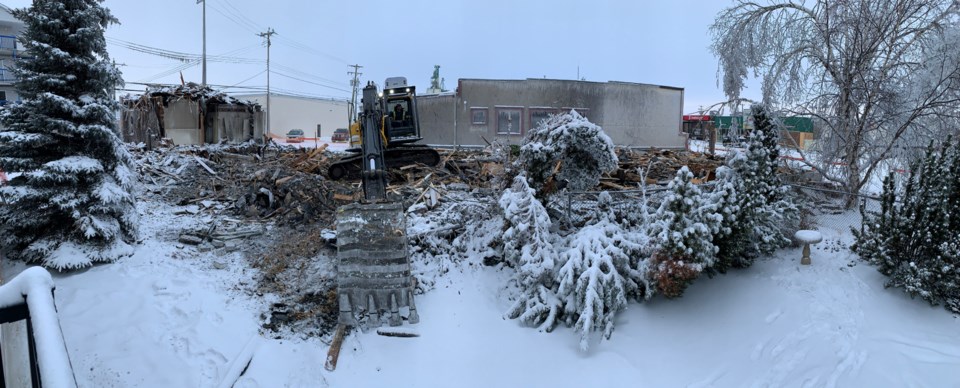WESTLOCK – In Stuart Koflick’s 11 years as chief of the Town of Westlock Fire Department he’s never faced a more challenging fire than the one that levelled the 76-year-old Commerce Building Jan. 31 and sent two people to hospital suffering from smoke inhalation.
The brick building’s two-storey construction circa 1940s, the frigid sub -20 C conditions they had to face in the middle of the night, the fact that there were people inside and its location on Main Street were just some of the obstacles that set this blaze apart. It was all hands of deck for the town department as pretty much all of the 15-member volunteer staff — including the department’s two junior firefighters — spent time on scene, while around 10 Westlock County firefighters, including two engines, were called in along with an aerial truck and crew from Barrhead.
“It’s a bit of blur to me right now looking back. I mean we had hoses freezing, we have nozzles freezing and things like hydraulics don’t always like to work when it’s really cold. Then there were the frozen gloves and breathing apparatus freezing up. And obviously there were issues with the runoff … the water was a real challenge for all of us. And then having it happen in the middle of the night mixed in with a lot of steam from the water created poor visibility,” Koflick recalled during a Feb. 3 interview.
“The type of structure created a bit of a challenge because the fire started in the one suite, but because of the void spaces it was travelling up and across the other side. And it’s a flat roof with tarpaper shingles and it travelled across there. So you hit tar with water and it flares back up. Accessibility to the building was also a problem — it’s in between two other buildings and it’s quite long … so there were really a lot of challenges.”
Koflick said as part of the department’s planning process they look at all the major commercial structures in town and map out a fire response. The Commerce Building was one they had looked at and knew it wouldn’t be an easy fight.
“This is one of the buildings that we’ve always looked at for potential for fire and rescue. So knowing the building and knowing the resources I had available I made the decision to request mutual aid from Westlock County and the additional request of a platform ladder from Barrhead,” Koflick explained. “Our ladder truck was out there (Monday) putting out the hotspots and was fine for that. But in providing an effective rescue in cases we needed that, as well as fire control, a platform truck was best suited for this type of structure.”
Interestingly, the town’s new platform truck from Rocky Mountain Phoenix arrived in Red Deer from its U.S. manufacturer Friday, Jan. 29, for the addition of more equipment and will be in town by the end of the month. After some additional training in Westlock the truck should be in service for the beginning of April.
Features of the truck include a water tank with the capacity of 500 gallons, a fire pump with flow rates up to 1,250 gallons per minute and a ladder reach of 75 feet to 104 feet vertical. The vertical reach and ability to extend the ladder horizontally over an area will help them in hard-to-reach areas and is ideal for rescues where there is limited space to maneuver.
“This recent fire shows that the decision that we as a municipality made to purchase the truck that we did — it’s very similar to the one from Barrhead — was a good one. It’s an aerial platform, it’s got a basket at the top, an elevated master stream and 105-foot reach. This fire illustrated the need for that kind of equipment in the Town of Westlock,” he said.
Koflick said the attention now turns to how the fire started as they’ve called in an independent fire investigator. By Wednesday most of the rubble from the structure had been pushed into the basement of the site, with security fencing around it.
“There’s quite a bit of stuff to look at. Sometimes it’s done quickly, sometimes it takes a month. I don’t anticipate it being long and drawn out,” said Koflick, who was scheduled to touch base with the investigator that day.
Fire flareups
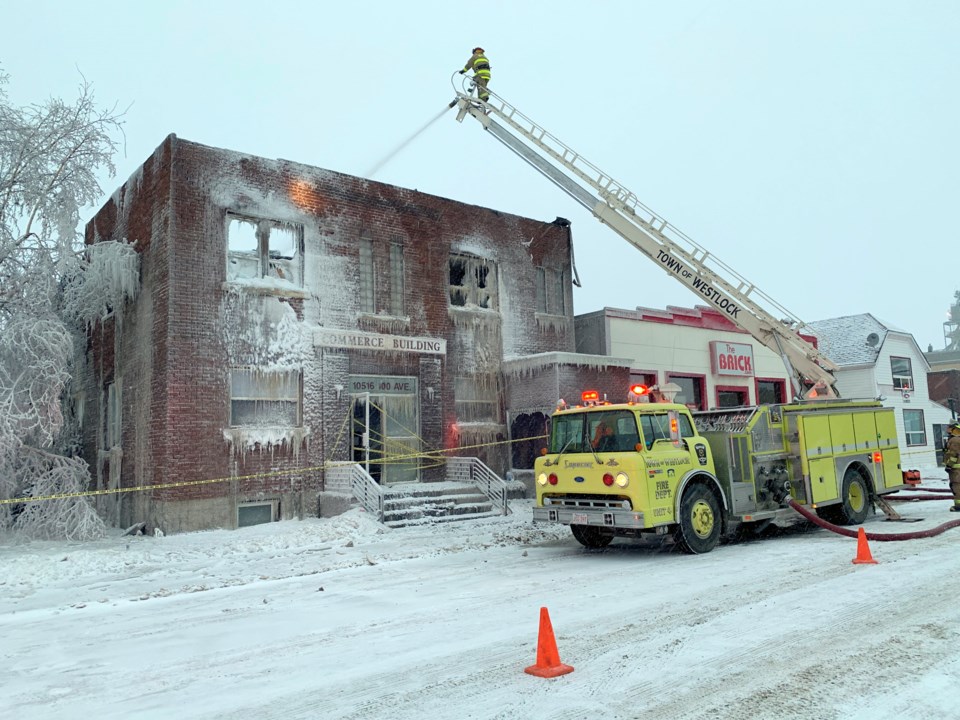
Until the rubble was pushed into the basement, the fire never was truly out. Koflick said they were called out numerous times because of continued flareups and it was due to those calls that the structure needed to come down.
“With a building of that age and that type of construction … the older type of construction, the wall continues from the foundation right up and it creates a void space and in there fire can travel throughout the building unimpeded until it hits a cross member of sorts. And in there was a mix of blown-in insulation and sawdust, which was typical of the time. And that sawdust is really difficult to extinguish completely unless you cut and expose a lot of the structure,” he explained.
“So we’d think we had it out, we’ve got thermal imaging, but it doesn’t take very much for it to start again. It could be a small, smoldering spot, then it generates enough heat and gets bigger and bigger and at some point it exposes itself and then we’re back at it. That ended up happening Monday at 4 a.m. and then again at 8 a.m. that day.
“So we started cutting and exposing as much as we could with the hoe, but we didn’t get all of it. On Tuesday we made the decision that in the interest of public safety — the entire structure had become unstable — to methodically go through the building, chase the void spaces and at the same time bring the building down so it eliminated the public safety issue.”
In between Koflick said they did their best to save what they could from inside, as well as a 100-year-old birch tree near the building.
“Firefighters like to rip, cut and smash things down, but at the same time we’re cognizant of the site … it’s called salvage and overhaul. When I talked to the property owner she had some requests to salvage some of the items from inside the building and we were able to meet those. There was an occupant of one of the suites who had some very important documents and we did our best to get everything for him,” he noted.
Crews never complained
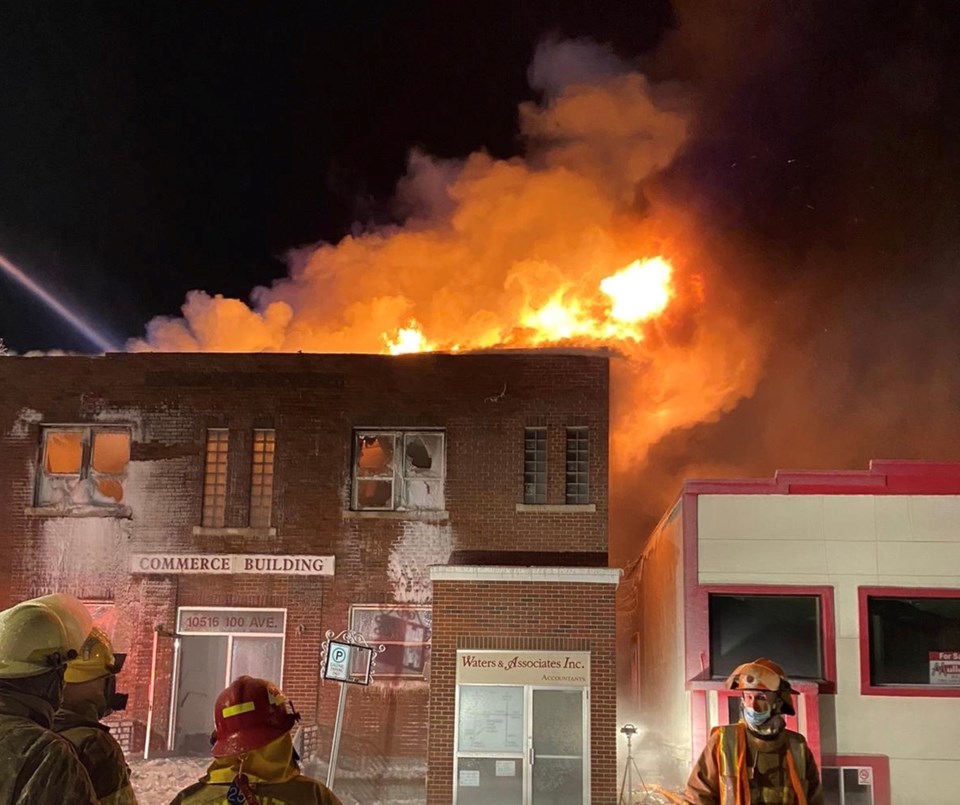
In addition to the fire Sunday and their continued on-scene presence during the flareups, town firefighters also assisted with the fatal crash on Highway 44 near Dapp Feb. 2.
“And they did it without complainant,” said Koflick. “Firefighters want to fight fires and when the fire is down, for lack of a better term, there’s a lot of grunt work that needs to be done — punching holes in walls, ripping drywall down. And that’s not the glamorous part of the job, but it’s something that’s crucial and needs to be done. And there were no complaints at all.
“Our guys are on 24/7 and they work until the job is done. We had a firefighter’s wife whose birthday was Sunday and he had to miss it because of the fire. I have to hand it to everyone involved. From the initial response, to getting called back at three, four and five in the morning, I can’t say enough about the asset that the town has in their department.”
Thanks to the community
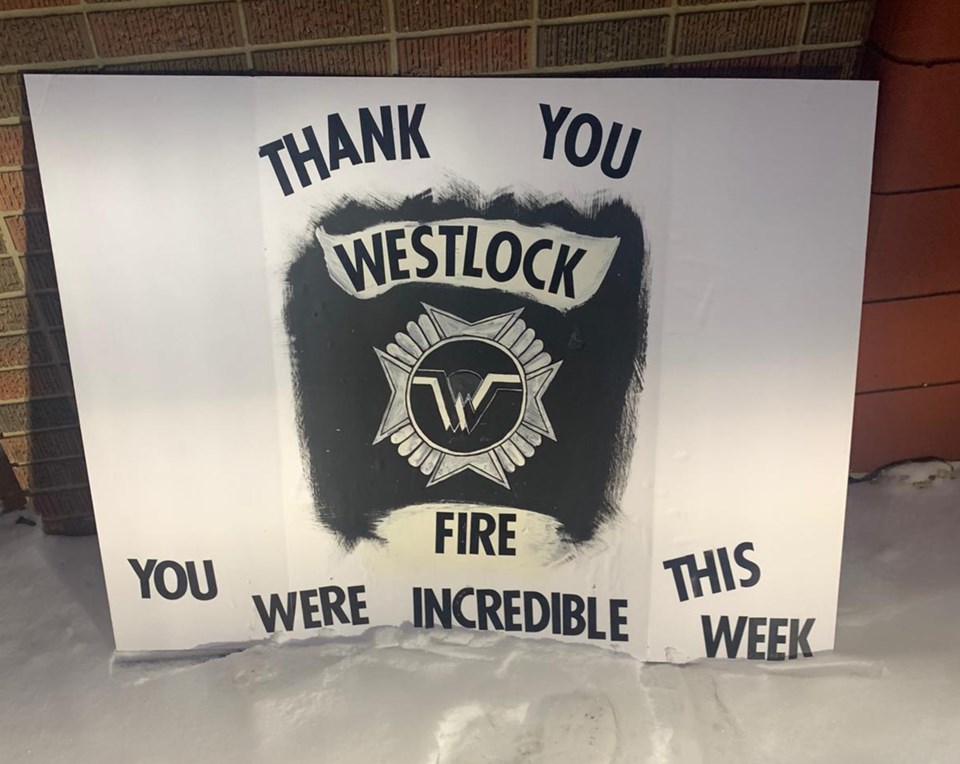
Koflick also gave kudos to the RCMP, who were on scene throughout Sunday, to public works, EMS crews and everyone else who pitched on.
“The RCMP also did a fantastic job not only securing the scene for us, but assisting with taking information from occupants and making sure everyone was out, because for the first 10 or 15 minutes we weren’t sure if everyone was out,” he said.
“From the contractor who was on site taking down the structure, to the public works employees that kept the catch basins open and worked tirelessly to chip the ice from Main Street to get it open … thank you. We even had someone drop off coffee and donuts to us and Kerri’s Café provided free lunches for us on Monday. We really appreciate the support from the community.”
And the community obviously appreciates their work as a poster thanking the department for the tireless efforts was dropped at the fire hall Feb. 3.
“Having that poster dropped off really choked me up. I would be lying to you if I said it didn’t make me emotional.”
Family saddened by loss
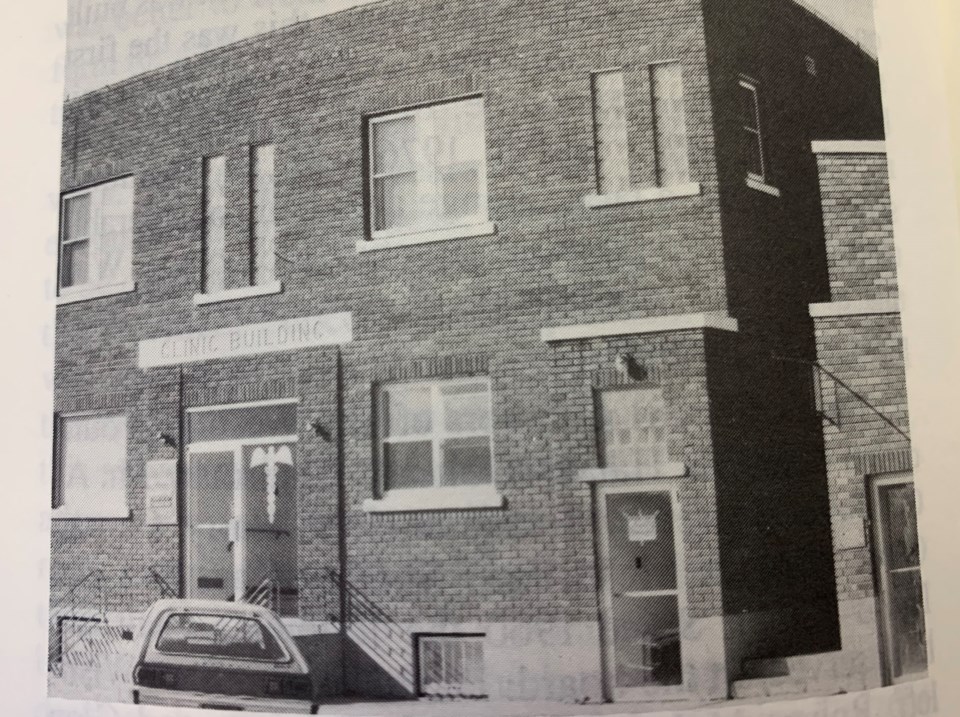
According to the community history book 80 Years of Progress, the building was constructed and opened by Dr. Georges L. Whissell in 1945 and was named apropos the Clinic Building — Dr. Frank Woodman was the first to join.
Following the blaze the Westlock News reached out to Dr. Whissell’s remaining children who said they were saddened by the loss of their father’s first clinic, which is no longer owned by the family. Dr. Whissell, who practiced medicine in Westlock for 55 years, passed away in 2006, while his wife Nellie passed in 1976.
The three remaining brothers, Bookie, Brian and Ron, relayed that the building was home to one of the first X-ray machines in northern Alberta and was unique in that it originally had a hot-water heating system fired by coal, which was eventually converted to natural gas. The building was also a one-of-a-kind in that in addition to housing the clinic, there were also rental suites, which were in use up until the fire.
Born in St. Andre Avellin, Que. Sept. 5, 1907, Dr. Whissell graduated in medicine from the University of Montreal in 1932.
Dr. Whissell, whose name adorns the park at the north end of Main Street and is also the namesake of Whissellville, came to town Jan. 1, 1942 and spent the first three month living at the Sheppard Hotel, which is now the Westlock Hotel — he had moved to Alberta from Quebec in 1938 and had originally started practicing medicine in Edmonton.
Unable to find a home in Edmonton, he first lived in Legal and commuted. According to the history book, once the Sisters of the Immaculata Hospital in Westlock learned of his arrival in the area they begged him to help out when there were emergencies, or when the other local doctor was unavailable.
Over the next few years Father Eugene Rooney, who was the parish priest at St. Mary Catholic Church for 49 years, became a dear friend to Dr. Whissell and finally persuaded him to move his family to Westlock and the rest, as they say, is history.
